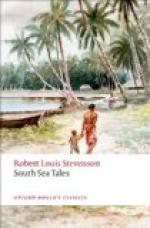On the afternoon before it was intended we should sail, a valedictory party came on board: nine of our particular friends equipped with gifts and dressed as for a festival. Hoka, the chief dancer and singer, the greatest dandy of Anaho, and one of the handsomest young fellows in the world-sullen, showy, dramatic, light as a feather and strong as an ox—it would have been hard, on that occasion, to recognise, as he sat there stooped and silent, his face heavy and grey. It was strange to see the lad so much affected; stranger still to recognise in his last gift one of the curios we had refused on the first day, and to know our friend, so gaily dressed, so plainly moved at our departure, for one of the half-naked crew that had besieged and insulted us on our arrival: strangest of all, perhaps, to find, in that carved handle of a fan, the last of those curiosities of the first day which had now all been given to us by their possessors—their chief merchandise, for which they had sought to ransom us as long as we were strangers, which they pressed on us for nothing as soon as we were friends. The last visit was not long protracted. One after another they shook hands and got down into their canoe; when Hoka turned his back immediately upon the ship, so that we saw his face no more. Taipi, on the other hand, remained standing and facing us with gracious valedictory gestures; and when Captain Otis dipped the ensign, the whole party saluted with their hats. This was the farewell; the episode of our visit to Anaho was held concluded; and though the Casco remained nearly forty hours at her moorings, not one returned on board, and I am inclined to think they avoided appearing on the beach. This reserve and dignity is the finest trait of the Marquesan.
CHAPTER III—THE MAROON
Of the beauties of Anaho books might be written. I remember waking about three, to find the air temperate and scented. The long swell brimmed into the bay, and seemed to fill it full and then subside. Gently, deeply, and silently the Casco rolled; only at times a block piped like a bird. Oceanward, the heaven was bright with stars and the sea with their reflections. If I looked to that side, I might have sung with the Hawaiian poet:




